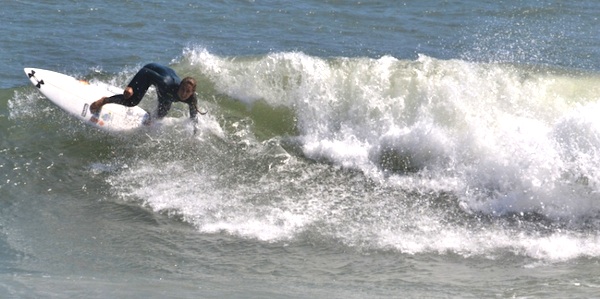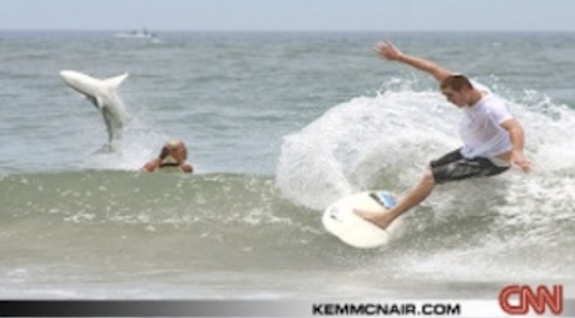Photos for Headline Surfer® / Above: Daniel True knows all too well what a shark bite feels like as shown in this graphic image from 2011 in the waters off New Smyrna Beach. Below: This teen gal surfer rides the curling waves without fear of the 5 foot spinner sharks trolling the waters in search of bait fish. Two teen boys were bitten by sharks Friday in New Smyrna Beach. YouTube video download / World 5 list counts down the top 5 beaches for shark attacks with New Smyrna Beach ranked No. 1. Video contains graphics images that may not be suitable for all age groups.
 By HENRY FREDERICK / Headline Surfer
By HENRY FREDERICK / Headline Surfer
NEW SMYRNA BEACH, Fla. -- With lots of young surfers in the water for a surfing contest Friday, it was inevitable someone was going to get bitten by a shark.
In this case two teen boys got their red badge of courage -- bites strong enough to draw blood and require stitches at nearby Bert Fish Medical Center.
The first bite occurred just before 2 p.m., Beach Patrol officials said.
The first was a teenage boy from South Carolina on his board and getting ready to stand when he felt the sting of a bite from a shark 3 to 4 feet long, which left him with a laceration on his foot.
Less than 30 minutes later, a Satellite Beach teen also was bitten on his lower left thigh while paddling in 5 feet of water. He suffered minor puncture wounds just above his knee.
Both teens were privately driven by friends or relatives to Bert Fish for treatment in the ER, said Tammy Marris, Bwach Patrol spokeswoman.
These were the first two reported shark bite incidents along Volusia County beaches this year. Last year there were seven shark bite incidents, most of them in New Smyrna Beach.
Bites have been far less than half a decade ago with no real explanation.
 Here's an eery sight with shark fins sticking up in the surf in New Smyrna Beach on Friday where two teen boys on surf boards were bitten within 30 minutes of each other.
Here's an eery sight with shark fins sticking up in the surf in New Smyrna Beach on Friday where two teen boys on surf boards were bitten within 30 minutes of each other.
2007 was the "Year of the Shark" in Volusia County with 22 bites, which then made 2008 the "Year of the Shark Part Deux," with 24 bite victims.
Just ask then-6-year-old Zane Atcha of Deltona in a year-end wrap up story on shark bites published in Headline Surfer in 2008. Getting bit by a shark surely opened his eyes to the attention he could get from grown-ups.
"This is pretty weird," the boy said after being released from the emergency room at Bert Fish Medical Center May 7, for a couple of stitches to close a small bite on his leg, and he wasn't referring to the shark.
Oh no, it was all the media attention with TV cameras focused on him and an earlier ambulance ride from the beach.
Asked about the bite, the boy said it was "kinda" worth it.
The boy was at the beach with his kindergarten graduation class when he was bitten in 18 inches of water off the 27th Avenue Beach Approach, further south of the South Jetty, where the majority of bites occurred and surfers were the victims.
The bites were mostly nips that required a quick stitch, though one surfer suffered tendon damage to one of his feet.
The record was never in doubt as the totals grew considerably as the weather warmed up -- the result of bait fish spawning in the Jetty -- the preferred food of the sharks -- some as long as 5 to 6 feet.
The mark was broken Sept. 28, and the victim was thought to be David Logan, 44, of Jupiter, but an hour earlier, David Carr, 40, of Deltona, was bitten, according to the Volusia County Beach Patrol, which clarified the information the following week.
Such distinctions can mean the difference in bragging rights on the beach for years, perhaps even a lifetime.
But sometimes, the bite can be pretty serious. Such was the case on Sept. 9, 2011, near New Smyrna Beach’s South Jetty. Daniel True, 19, was bitten on his right foot while wading in 4 feet of water with his board.
The surfer was able to get to shore where he received medical attention by a lifeguard. Then he drove himself to Bert Fish Medical Center for stitches to close the sizable bite wound on the ankle and big toe area. The Beach Patrol's Marris said the teenager was attacked by a 6-foot shark, based on the size of the bite.
True told reporters he’d be back riding the waves on his board as soon as he got his stitches removed. Indeed he was.
True, then 19, chronicled his misadventure on Facebook, writing: "Well, just had a swell day! Except for the 6 ft black tip that decided to try to eat my foot this morning!!!" He added: "With my luck I'll get struck by lightning tomorrow."
True, then 19, chronicled his misadventure on Facebook, writing: "Well just had a swell day! Except for the 6 ft black tip that decided to try to eat my foot this morning!!!" He added: "With my luck I'll get struck by lightning tomorrow."
'Shak Bite Capital of the World'
Volusia County is known as the Shark Capital of the Worl,d not the severity of the bites, but rather the frequency of the attacks.
The shark capital reference may have originated from from a 1991 Associated Press interview with Samuel H. Gruber, a professor of marine biology at the University of Miami, who identified the shark attacks near the South Jetty as being "perhaps the shark attack capital of the world."
The shark capital reference may have originated from from a 1991 Associated Press interview with Samuel H. Gruber, a professor of marine biology at the University of Miami, who identified the shark attacks near the South Jetty as being "perhaps the shark attack capital of the world."
Volusia County's beach-line stretches nearly 50 miles from Ormond by-the-Sea near the Flagler County line to the section in Daytona Beach known as the "World's Most Famous Beach, to Cape Canaveral Seashore south of Oak Hill and Mosquito Lagoon.
But most of the annual shark attacks occur in a 1-mile stretch at the South Jetty, straddling Ponce Inlet and New Smyrna Beach, according to George Burgess, director of the International Shark Attack Files at the University of Florida in Gainesville.
Burgess has said nearly 40 percent of the world's shark attacks occur right here in New Smyrna Beach where the surfing is among the best on Florida's Atlantic coast.
Burgess told Reuters the fatal attack by a shark was the first such death in Southern California since 1959.
Attacks on the Atlantic coast are much common, especially in Florida, which has about 25-30 a year, Burgess has said, adding they are rarely fatal because they usually involve a much smaller species of shark.
Back here in New Smyrna Beach, Josh Burgess, no relation to shark expert George Burgess, takes the shark attacks in stride: "It's like smoking cigarettes. You know what you are getting yourself into. The sharks are there. They're not going to go away. You just learn to deal with it."
News of shark bites is no news to Burgess, then-25 25, when he was interviewed several years ago by Headline Surfer when the bites were more frequent.
"I've lived here all my life -- I've learned to live with it all my life," he said, asking rhetorically, "Aren't we the shark capital of the world and all that?"
Burgess said the sharks here are nothing compared to the great white, made famous by the man-eating monster from the movie Jaws.
"The sharks here bite you -- the sharks like that one in (California) eat you whole." He was referring to the fatal shark attack where, as Reuters News Service reported, a 66-year-old man was attacked and killed by a shark in the ocean near San Diego, the first person to die in a shark encounter off Southern California in nearly 50 years.
The victim, identified as retired veterinarian David Martin, was swimming with a group of triathletes about 150 yards off Solana Beach north of San Diego when he was attacked by what experts said was probably a great white shark.
Solana Beach Deputy Fire Chief Dismas Abelman said rescue crews found Martin being dragged from the sea by other swimmers, bleeding profusely from injuries to his legs. He was treated at the scene but was pronounced dead before an air ambulance could get him to a hospital, Reuters reported.
"We are all shocked and dismayed at the events that happened here this morning," Solana Beach Mayor Joe Kellejian told the media, while urging residents to heed warnings by officials. "We don't want people to panic. We do want them listen public safety officials," Kellejian said.
An 8-mile stretch of beach was closed to swimmers for 72 hours while Coast Guard helicopters looked for the shark.
Abelman said it would not necessarily be killed if it were found but, "We want to know where it is." Authorities have not determined what species was involved, but experts said that given the size and severity of Martin's injuries it was almost certainly an adult great white.
Shark attacks always seem to grow into tall tales. like Burgess's description of the California victim being swallowed whole or the large pools of blood from the attacks in the movie Jaws that could fill a swimming pool with blood from a single attack.
And the mayor's comments where the shark attack occurred is a reminder of the verbal sparing between the police chief in Jaws who wanted the beach closed and the mayor who was worried about lost revenue. Still, any description of a shark is scary -- real or imagined.
Headline Surfer® asked Volusia County Beach Patrol Capt. Jack Driskell to describe the sharks that swim here in our back yard. He said they are smaller -- mostly spinner sharks -- and because of murky waters caused by strong winds and shifting sands, their visibility is limited.
 Photo for Headline Surfer® / Local photographer and surfer Kem McNair received worldwide recognition for his July 3, 2008, photo of a 5-foot spinner shark in the surf in New Smyrna Beach.
Photo for Headline Surfer® / Local photographer and surfer Kem McNair received worldwide recognition for his July 3, 2008, photo of a 5-foot spinner shark in the surf in New Smyrna Beach.The sharks often mistake human limbs -- feet, hands, calves, elbows and knees for fish.
The sharks simply bite and release once they realize the catch is human. Driskell said. These sharks are 4 to 5 feet in length and weigh 40 to 50 pounds, he said.
They tend to hug the shore line looking to feed on bait fish -- fingerling mullet and other small fish.
The great whites, like the one in the fatal California attack, pull their prey under with their powerful jaws and rip with their razor teeth, experts say, adding that shark likely mistook the man for a seal, which is more typical prey.
"They attack from below and make a tremendous, powerful rush and a very powerful bite, then pull away and wait for the seal or marine mammal to bleed to death before they come back," Richard Rosenblatt, a marine biologist at the University of San Diego's Scripps Institution of Oceanography, told Reuters.
No one locally has died from a shark attack. Still the media feeding frenzy makes it seem worse.
Here is a link to shark attacks around the world: http://sharkattackfile.info/index.asp.
Previous Related Stories:
 Henry Frederick is publisher of Headline Surfer, the award-winning 24/7 internet news outlet launched 12 years ago that serves greater Daytona Beach, Sanford & Orlando, Florida via HeadlineSurfer.com. Frederick has amassed more than a hundred journalism industry awards in print & online -- more than than all other members of the working press combined in Central Florida since the mid-1990s. He earned his Master of Arts in New Media Journalism with academic honors from Full Sail University in 2019. Having witnessed the execution of serial killer Aileen Wuornos in Florida's death chamber and other high profile cases, Frederick has appeared on national crime documentary programs on Discovery ID and Reelz for his investigative reporting and cops & courts breaking news stories.
Henry Frederick is publisher of Headline Surfer, the award-winning 24/7 internet news outlet launched 12 years ago that serves greater Daytona Beach, Sanford & Orlando, Florida via HeadlineSurfer.com. Frederick has amassed more than a hundred journalism industry awards in print & online -- more than than all other members of the working press combined in Central Florida since the mid-1990s. He earned his Master of Arts in New Media Journalism with academic honors from Full Sail University in 2019. Having witnessed the execution of serial killer Aileen Wuornos in Florida's death chamber and other high profile cases, Frederick has appeared on national crime documentary programs on Discovery ID and Reelz for his investigative reporting and cops & courts breaking news stories.